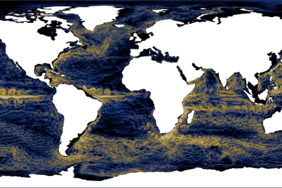EERIE aims to develop a 10 km resolution version of the coupled model ICON-ESM for the atmosphere and ocean to study climate response and climate variability in an eddy-rich ocean. This scale of a few 10 kilometers to 100 kilometers, also called the ocean mesoscale, is important for the Earth system. This is because, on the one hand, mesoscale ocean eddies influence the transport of heat, freshwater, and substances such as carbon, especially to the deeper ocean. On the other hand, the mesoscale ocean fronts — elongated boundary zones in the ocean where the horizontal temperature gradients are particularly large — cause an enhanced interaction between the atmosphere and the ocean. Thus, they influence atmospheric variability and climate extremes.
One of the scientific aims of the project is to explore possible multiple equilibria and the stability of the Atlantic overturning circulation (AMOC), which have not been studied before in an eddy-rich coupled model. Specifically, multiple equilibria would mean two equilibrium states of the AMOC, “on” or “off”. If the AMOC would come to a standstill (“off”), this would have serious consequences for the climate, especially in Europe. However, previous model studies and theories that consider such multiple equilibrium states possible have not included the influence of eddies. EERIE is designed to change that and explore the effect of eddies on both the existence of multiple equilibrium states of the AMOC and the time-varying response (transient response) of the AMOC to global warming.
EERIE will advance coupled km-scale modeling, supporting MPI-M´s current institute strategy regarding high-resolution Earth system modeling for global and regional climate change predictions in the context of the large-scale projects nextGEMS and DestinE. By leveraging the latest advances in science and technology, EERIE is expected to enable climate scenarios with simulations of very high spatial resolution over several hundreds of years. The model improvements include new dynamical cores, new components (particularly sea ice), scale-aware parametrization and the complementary use of Machine Learning. The technological challenge associated with this ambition is very high. It would be a great success to achieve a simulation speed of 5 years per day (5 SYPDs) in EERIE. This is to be done in an efficient way, with a 50 % reduction in power consumption, in order to exploit the pre-exascale supercomputers now available in Europe.
The total funding for the project is just under 10 million euros over 4 years for 17 participating research institutions. The MPI-M receives 1 million euros for its research. The project is coordinated by the Met Office, England.
More information
nextGEMS:
https://nextgems-h2020.eu/
Destination Earth (DestinE):
https://digital-strategy.ec.europa.eu/en/policies/destination-earth
Contact
Prof. Dr. Jin-Song von Storch
Max Planck Institute for Meteorology
Email: jin-song.von.storch@mpimet.mpg.de

